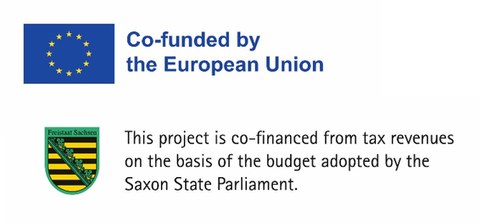Research and development projects in the health, care and social sectors that improve the care of the population and cooperation between the various stakeholders, in particular by networking citizens, patients, health, care and social service providers. The projects serve the research and development of new products, processes and services. The core area of outpatient and inpatient healthcare and nursing care is excluded from funding.
- The following areas are funded:
a) E-health and digital health applications,
b) age-appropriate assistance systems for a self-determined life in old age,
c) intelligent, cross-sectoral and interdisciplinary health and care networks, including digital networking of facilities in the health and care sector,
d) social innovations,
e) innovative pilot projects.
a) E-health and digital health applications
The "e-health and digital health applications" funding item is intended to encourage companies to develop solutions and products for the health and care industry in order to not only support medical and nursing care, but also to be regionally and internationally competitive with such products in the medium term. The aim is to be able to provide the same level of medical and nursing care in regions with an acute shortage of skilled workers, particularly in rural areas. In addition to the development of new products, the use of existing technologies can also be adapted and appropriately integrated.
Synergy effects or the use of new, digital and e-health solutions will provide the necessary relief for medical and/or nursing staff, who will then be available for other tasks. At the same time, the health and care industry/life science sector holds enormous economic potential for companies, both in the area of statutory health insurance and in products for private households (e-care and home care). The measure is also intended to strengthen the innovative power of companies in rural regions in order to develop and offer "local" solutions. In order to maximize market potential, service providers and cost bearers in the statutory health insurance sector should be involved in the development of products and solutions. In addition, the health and care industry in particular has a need to catch up in terms of development cooperation with universities or public research institutions. Cooperation in this area is therefore eligible for funding.
The application of the products, processes and services in healthcare is a key component of the funding requirement. [to the overview]
b) Age-appropriate assistance systems
Technical assistance systems contribute in particular to promoting the independence and social participation of older people. The focus of the use of technology is on the areas of communication, mobility and living that are relevant to everyday life (ambient assisted living - AAL). Funding is also provided for technologies that promote the use of assistance systems. The innovative assistance systems for a self-determined life in old age, which originate from the various fields of technology, make it possible to mutually network different service areas (medical services, care services, housing, management, mobility) and to develop interdisciplinary, innovative solutions for the outpatient care of older people. The resulting technology-based solutions will help to balance the future need for care in the Free State of Saxony and reduce the financial burden. [to the overview]
This funding object is intended to support companies in tapping the market potential of AAL solutions and thus reducing the demand for expensive inpatient care services. As a result, reliable AAL solutions are intended to relieve the burden on skilled workers in outpatient care and the relatives of those in need of care. The aim must be to enable elderly people or those in need of assistance to remain in their own homes for longer and to maintain their independence. This also goes hand in hand with the (longer) use of living space in rural regions. Overall, the promotion of AAL measures results in a wide range of benefits for citizens, companies and public authorities. The innovative products, services and models improve healthcare provision.
The use of the products, processes and services in the provision of care is a key component of the funding requirement. [to the overview]
c) Health and care networks including digital networking
The strong sectorization (outpatient, inpatient and care sector) in the German healthcare system is a legally regulated structural peculiarity. This sectorization leads to considerable material and personnel inefficiencies at the interfaces between the three areas (e.g. duplicate documentation or multiple medications) as well as loss of information to the detriment of the population and the stakeholders involved in care. Smart technologies open up new possibilities, so that not only a cross-sector solution, but also interdisciplinary networks are established. Such networks should be in line with the funding objectives and objects and thus contribute to a patient-oriented and significant improvement in the healthcare system and open up market potential for companies.
For sustainable and efficient healthcare, it is particularly important to digitize data exchange in the health and care sector as far as possible. Digitizing data exchange will make a significant contribution to simplifying work processes, reducing personnel and financial expenditure and improving the quality of care in the health and care sector. It must be possible to exchange data easily and inexpensively so as not to place an additional burden on specialists and increase the associated costs.
The digital networking of health and care facilities is a prerequisite for improving cross-sector, integrated care. The expansion of digital network structures helps to avoid efficiency and information losses at the interfaces between the sectors by expanding network structures between participants in care, companies and research institutions. The measure is also intended to generate and exploit synergy effects, such as cost savings. Particularly in rural areas, new care structures and processes can be developed and established through the networking and implementation of innovative, cross-sector solutions. [to the overview]
d) Social innovations
The promotion of (primarily digitally supported) research and development of social innovations can make a key contribution to tackling pressing future issues for the development of society and strengthening social cohesion. To this end, the promotion of innovative research and development projects in the field of social innovation should be directly linked to the search for solutions to social problems and challenges. These solutions often involve new forms of communication and cooperation. [to the overview]
e) Innovative model projects
An innovative model project exists when products, processes or services are implemented, their acceptance, economic efficiency, optimization and market potential are tested and, if necessary, further necessary adjustments are derived from this. In addition, it demonstrates a particular level of innovation, at least in a national comparison. The focus here is on measures for telematic, interdisciplinary networking. These include innovative forms of organization, cooperation models and technical solutions that focus on interoperability and a high degree of networking. A networking measure is considered interdisciplinary if healthcare providers from different departments or different areas of care, for example outpatient care, inpatient care, rehabilitation, pharmaceutical care, are involved and not only companies belong to the network, but are related as affiliated companies or partner companies. [to the overview]
 © TU Dresden
© TU Dresden

